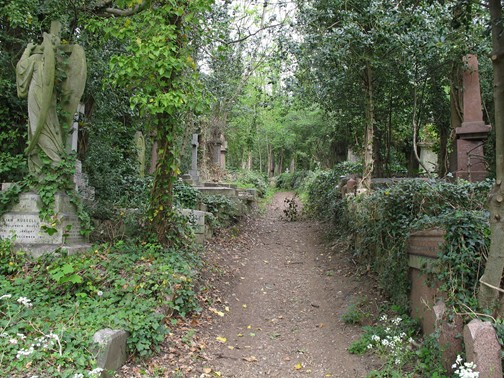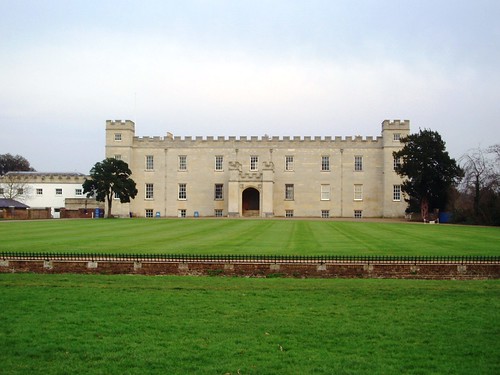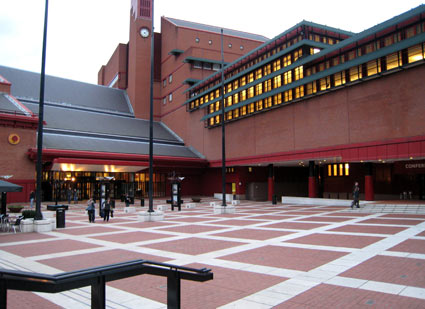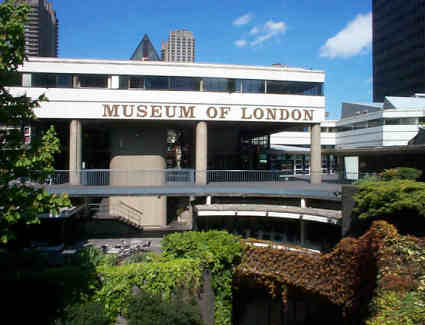
Exploring London: One Tube Stop At A Time
Monday, August 8, 2011
High Gate Cemetery: A Peaceful and Sentimental Park

A Sticky and Warm Afternoon in Syon Park

The British Library: A Cruise Liner


London: A Busy Beehive

The Museum of London is an oddly shaped building that is located in an industrial part of London. The museum’s exterior, comprised of dark gray stones, makes the museum appear dreary and unwelcoming. On the inside, however, the museum is like a busy beehive. It is filled with cafés, a souvenir-filled gift shop, and many exhibitions that range from the time of the cave man to modern day London. The museum brings the history, the many types of people that have populated London, and the many dilemmas and the crises of the English people.
The Romans, the Protestants, and eventually the Chinese and Muslims, and many other people from other nations all came to live in London. There were a few exhibits I truly found very entertaining and interesting. The exhibition on the Romans showed how they contributed to British culture by developing stone paved roads, aqueducts, and currency. The exhibition on the Reformation showed how the Church of England was developed and how the church united the British people under one religion. The Exhibition on London’s Great fire showed how fires were pretty common in London. London experienced fires frequently through out the past two thousand years, starting in 60 AD and continuing through 1666 when the Great Fire occurred and lasting till present day. One of London’s greatest threat still remains to be fire. The Victorian exhibit showed the many innovations created during the reign of Queen Victoria in the 1800s such as stagecoaches, railways, a sewage system, and electricity. Lastly, the modern day exhibit ended with a collection of clothing demonstrating the “London Look” through the years, ranging from the 1950s till present day. I was interested in learning about what the “London Look” consisted of. According to the inscription, the “London Look” is “is a melting pot with a rebellious edge. It brought street style to the catwalk, mixed British traditions with ethnic sensibilities and valued irreverence, innovation, and wit. The “London Look” expresses the broader spirit of London, an idiosyncratic, post-colonial world-city, mixing old and new.”
After finishing my tour at the Museum of London, I realized how diverse London truly is. A quote I stumbled upon in the museum does a wonderful job in accurately describing the city of London as the following: “London is the great beehive of Christendom…she swarms with people of all ages, natures, sexes, callings…she seems to be a glutton, for she desires to always to be full.”
The Immortality of Emotions

Shakespeare’s Globe theater contains an elaborately designed stage filled with color: blue, green, and red, gold trimmings, and ornate columns. On stage, both actors and actresses created a context mimicking that of the 1600s with their Old English jargon and their flashy clothing. Even though the actors and actresses were trying to act out a story that takes place during the 1600s, the emotions that each character experienced is similar to those all humans through out the world experience. In the play, “All’s Well That Ends Well shown in the Globe Theater, the viewer can especially not only relate to Helena ‘s emotions but can also consider Helena as a role model for her strength and courage.
In Shakespeare’s “All’s Well that Ends Well,“ Helena is a young petite blonde woman who recently lost her father. As a result, she is placed under the Countess’ supervision. Helena demonstrates her courage while living with the Countess by voicing her feelings for Bertram to his mother, the Countess. Another instance Helena demonstrates strength and courage is when she travels to Paris to help cure the King of France of a fistula. As a result, the King grants her the opportunity to choose a husband from the king’s court where Bertram was residing. Of course, she chooses Bertram, much to his dismay. For this reason, Bertram states that he will never love Helena, unless she is capable of getting his family ring from his finger and becoming pregnant with his child. Of course, Helena becomes very anxious and distraught which is to be expected especially when the person you love rejects you and gives you an ultimatum. She does not know how she can get the ring from his hand or even become pregnant with his child without him noticing. She even becomes hopeless. However, with the support of the Countess, Helena is able to turn an impossible situation into a possibility.
The Countess informs Helena that Bertram has become a general in the Duke’s army in Florence. As a result, Helena leaves France and travel to Florence. Once in Florence, Helena discovers that Bertram is trying to seduce Diana, the virginal daughter of a widow, who is not interested in Bertram. So, Helena cleverly devises a plan where Diana has to request Bertram to give Diana his family ring and to have him sleep with her. When Bertram gives Diana his ring, Diana runs back and gives Helena the ring. And then, when Bertram goes to sleep he thinks Diana will come to his bed, but instead Helena comes, whom he does not notice. Eventually, Helena confronts Bertram and shows him that she was able to overcome the obstacles Bertram placed in front of Her. By overcoming these obstacles, Helena proved not only her strength and courage but also her love for Bertram.
Not only does the viewer sympathize with Helena when Bertram rejects her, but also the viewer looks up to her as a role model for her clever ability and her strength. Even though this play took place in the 1600s, the emotions involved in this play such as, rejections, frustration, and hopeless, are emotions humanity daily. It does not matter whether it is the 1600s, 2011, or 3000 because everyone experiences the same feelings with certain emotions; Thus, making emotions immortal.
Looks Always Deceive The Eye

Cinderella Banzon and I met the first day we arrived in London. While waiting for the bus at Heathrow Airport, I learned she was going to be my roommate during our stay in London. We were both in the same London Study Abroad program that would be taken through Heythrop College. However, we were both registered for different classes. She was registered for the Hitchcock class while I was registered for the creative writing class. My first impression of Cinderella was vey different from the Cinderella I came to know. At first, she seemed very sweet, quiet, and shy. However, after spending a few weeks with her, she proved to be very comical and adventurous.
Cinderella resides in New York City with her family. She is the only child. She is bilingual. Her first language was Tagalog. She is currently a rising junior at Fordham University’s Lincoln Center campus. She is majoring in communications with a concentration in film studies. Two of her favorite places to visit are Lincoln Square and Covent Gardens. She hopes to someday live in Covent Gardens. She loves to journal and listen to the Queen, the Who, Cold Play, Elvis, and Florence and the Machine. Her favorite movie is An Education because the main character, Jenny, experiences a personal growth within the movie. This movie is one of her favorites because Jenny, who comes from a middle class family, gets briefly exposed in living a glamorous life. Her second favorite movie is Sabrina, which stars Audrey Hepburn. Audrey is Cinderella’s favorite actress and her role model. She looks up to Audrey for being the “epitome of goodness,” caring, sincere, graceful, and a fashion icon.
At first glance, Cinderella seems to be a sophisticated and demure young lady. However, by chatting with her one late night I discovered that she is very adventurous. She told me that she recently went bus hopping throughout London by herself . She loved the experience especially since she went by herself. Besides going bus hopping, Cinderella has done other adventurous stuff. She went to a shooting range with her dad and uncle in the Philippines. She has traveled throughout the Philippines and Europe. What’s next on her agenda? She will be traveling to Egypt for a week after she finishes her study abroad program here in London. Cinderella has proved to me that she is not as shy and quiet as she seems. She enjoys going on adventures and living life to the fullest.

